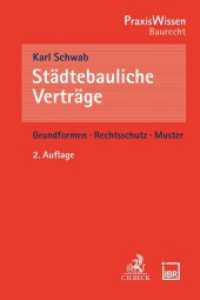- ホーム
- > 洋書
- > 英文書
- > Science / Mathematics
Full Description
This book - a sequel of previous publications 'Flows and Chemical Reactions' and 'Chemical Reactions in Flows and Homogeneous Mixtures' - is devoted to flows with chemical reactions in heterogeneous environments. Heterogeneous media in this volume include interfaces and lines. They may be the site of radiation. Each type of flow is the subject of a chapter in this volume.
We consider first, in Chapter 1, the question of the generation of environments biphasic individuals: dusty gas, mist, bubble flow. Chapter 2 is devoted to the study at the mesoscopic scale: particle-fluid exchange of momentum and heat with determination of the respective exchange coefficients. In Chapter 3, we establish simplified equations of macroscopic balance for mass, for the momentum and energy, in the case of particles of one size (monodisperse suspension). Radiative phenomena are presented in Chapter 5.
Contents
PREFACE ix
LIST OF MAIN SYMBOLS xv
CHAPTER 1. GENERATION OF MULTIPHASE FLOWS 1
1.1. Creation of suspensions of solid particles in a gaseous phase 1
1.1.1. Creation of a homogeneous suspension of starch particles 2
1.1.2. Soot formation 3
1.2. Creation of suspensions of bubbles in a liquid 5
1.2.1. Example of creation of a suspension of bubbles in a liquid 5
1.2.2. Influence of gravity on suspensions in pipes 7
1.2.3. Slug flows 8
1.3. Creation of suspensions of drops in a gas 9
1.3.1. Destabilization of fluid sheets and layers 10
1.3.2. Formation of droplets from filaments 22
1.3.3. Numerical simulation of primary atomization 32
1.3.4. Secondary atomization 42
CHAPTER 2. PROBLEMS AT THE SCALE OF A PARTICLE 47
2.1. Force exerted by a fluid on a spherical particle 48
2.1.1. Perfect incompressible fluid 48
2.1.2. Incompressible viscous fluid 51
2.2. Heat exchanges 59
2.3. Combustion of a drop of fuel in an oxidizing environment 61
CHAPTER 3. SIMPLIFIED MODEL OF A NON-REACTIVE FLOW WITH PARTICLES 65
3.1. Variables characterizing the flow 66
3.2. Balance equations 68
3.2.1. Balances for the particles 69
3.2.2. Balances for the gaseous phase 71
3.2.3. Entropy balance and phenomenological relations 71
3.3. Application to the linearized study of sound propagation in a non-reactive dilute suspension 74
3.4. Two-phase dilute flows in nozzles 78
3.4.1. Flow with constant phase shifts 79
3.4.2. Numerical solutions 82
CHAPTER 4. SIMPLIFIED MODEL OF A REACTIVE FLOW WITH PARTICLES 85
4.1. Balance equations for a reactive fog 85
4.1.1. Balances for the droplets 86
4.1.2. Balances of the mixture 88
4.1.3. Gaseous balances 90
4.1.4. Entropy balance of the spray and phenomenological relations 90
4.1.5. Equations of the two-phase CEDRE solver 92
4.1.6. Modified equations to take account of an internal temperature gradient of the drops: multi-layer model 93
4.2. Application to a spray flame 98
4.2.1. Application of a minimum model to the study of the threshold of appearance of a pulsating flame 98
4.2.2. Application to the study of the resonant action of an acoustic wave on a spray flame 102
CHAPTER 5. RADIATIVE PHENOMENA 105
5.1. Basic values and fundamental relations in radiative transfer 106
5.1.1. Definitions 106
5.1.2. Radiative Transfer Equation (RTE) 108
5.1.3. Radiative flux and power 110
5.1.4. Involvement of radiative heat transfer in the equations of aerothermochemistry 113
5.1.5. Turbulence-radiation interaction (TRI) 118
5.1.6. Modeling of the radiative properties of gases 119
5.1.7. Modeling of the radiative properties of the particles 124
5.2. Application to the hypersonic flow of atmospheric re-entry 127
5.2.1. One-dimensional approximation for a re-entering body 128
5.2.2. 3D calculations for a body experiencing re-entry 130
5.3. Application to the boundary layer above a flat plate with soot formation and radiative transfer 132
5.3.1. Recap on a boundary layer with diffusion 133
5.3.2. Reminders about the Emmons problem 136
5.3.3. Influence of soot and radiative transfer 142
5.4. Application to combustion of aluminum-based solid propellants 144
APPENDIX. CONCEPTS SURROUNDING THE HOPF BIFURCATION 149
BIBLIOGRAPHY 153
INDEX 173




